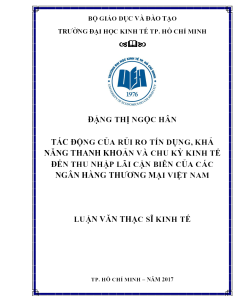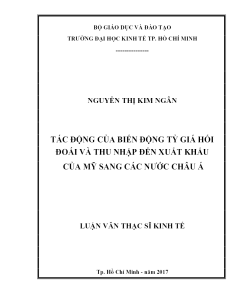- Giảm 10% phí tải tài liệu khi like và share website
- Tặng 1 bộ slide thuyết trình khi tải tài liệu
- Giảm 5% dịch vụ viết thuê luận văn thạc sĩ của Luận Văn A-Z
- Giảm 2% dịch vụ viết thuê luận án tiến sĩ của Luận Văn A-Z
Explore the integrated multi-channel shopping experience journeys: the role of integrated multi-channel impacts on customers’ integrated multi-channel shopping value
50.000 VNĐ
Download Master Thesis: Explore the integrated multi-channel shopping experience journeys: the role of integrated multi-channel impacts on customers’ integrated multi-channel shopping value
Download Master Thesis: Explore the integrated multi-channel shopping experience journeys: the role of integrated multi-channel impacts on customers’ integrated multi-channel shopping value
Due to constant change is one of the defining characteristics of contemporary societies, and obviously the retail industry. This claim is confirmed by theoretical and empirical research that seeks to solve the ongoing digitalization and retail innovation. It includes fluctuations in business models, increasing the diversity of channel and store formats, from changing retail technology to fundamentally new ideas and concepts. These challenges require retailers to devise new strategies to capture and meet the escalation of customer expectations. Recognizing the change of the new business context, physical retailers today have made the switch from communication model to applying multi-channel business model combining e-commerce and establishing door. fixed row. To support this, the author studies how retailers have integrated shopping channels and interacted with customers.
Thereby solving the problem of product satisfaction and creating seamless customer experience with special value, thereby leading consumers to expect consistent service and even lead to brand experience experience. personalized. In parallel, digitalization gives consumers access on the internet to increase their expectations in terms of shopping. Therefore, it has given them the ability to be consistent, replace and simultaneously use countless offline, online and contact channels throughout their shopping journey, which makes too many channels available. shopping, there will be more journeys and a lot of potential customers’ unexplored shopping motives to be the void of this topic.
After evaluating the results of the research with reality, the thesis described the relationship between the initial motivation of shopping for different shopping channels and the integration of shopping channels together. The opposite effect on customer purchasing motivation. And more specifically, the research results that answer the question of measuring the level of multi-channel experience high or low will depend on the exposure and navigation of retailer shopping channels for customer types.
That is, from shopping results show that the initial needs of customers will be enhanced more or less when starting at different channels and will eventually bring different shopping value to customers. The results of this research have great implications for companies that care for customers, individuals working in marketing, advertising and psychologists in customers’ shopping. Beneficiaries are customers when they experience the perfect shopping journey and feel satisfied with the product or service. Along with that are retailers when their products are preferred by customers and choose to buy.
Keywords: Teleshopping, Electronic commerce, Integrated multi-channel shopping
1.1. Research background and research problem……………………………………………………………… 1
1.1.1. Integrated Multi-channel: ………………………………………………………………………………1
1.1.2. Research background and research problem……………………………………………………..3
1.2. Research objectives……………………………………………………………………………………………….. 5
1.3. Scope and subject of the study………………………………………………………………………………… 5
1.4. Research methodology…………………………………………………………………………………………… 6
1.5. Research significance…………………………………………………………………………………………….. 6
1.6. Thesis structure………………………………………………………………………………………………………7
CHAPTER 2: LITERATURE REVIEW…………………………………………………………………………….8
2.1. Literature Review………………………………………………………………………………………………….. 8
2.1.1. Variety-seeking Behaviour Theory…………………………………………………………………. 8
2.1.2. Variety of Touch Points and Distribution Channel models………………………………… 9
2.1.2.1. Offline Channel……………………………………………………………………………………….. 10
2.1.2.2. Online Channel…………………………………………………………………………………………10
2.1.2.3. Distribution Channel models………………………………………………………………………11
2.1.3. Shopping Value in Customer Shopping Journeys…………………………………………….13
2.2. Hypothesis development………………………………………………………………………………………..16
2.2.1. Channels’ value dimensions………………………………………………………………………….16
2.2.2. Integrated multi-channel Shopping Value……………………………………………………….17
2.3. Research model…………………………………………………………………………………………………….20
2.4. Chapter Summary………………………………………………………………………………………………… 21
CHAPTER 3: RESEARCH METHODOLOGY………………………………………………………………. 23
3.1 Research procedure………………………………………………………………………………………………..23
3.2. Research paradigm………………………………………………………………………………………………. 24
3.3. Qualitative study…………………………………………………………………………………………………..25
3.3.1. Research design…………………………………………………………………………………………..25
3.3.1.1. Sampling………………………………………………………………………………………………….25
3.3.1.2. Data collection………………………………………………………………………………………….26
3.3.1.3. Data analysis technique……………………………………………………………………………..26
3.3.2. Qualitative findings…………………………………………………………………………………….. 27
3.3.2.1. Research model……………………………………………………………………………………….. 27
3.3.2.2. Modified scale items………………………………………………………………………………… 28
3.3.2.3. Measurement scale…………………………………………………………………………………… 38
3.4. Main quantitative study………………………………………………………………………………………… 42
3.4.1. Sampling…………………………………………………………………………………………………….43
3.4.2. Data analysis techniques……………………………………………………………………………… 43
3.5 . Chapter summary…………………………………………………………………………………………………44
CHAPTER 4: DATA ANALYSIS……………………………………………………………………………………. 46
4.1 Respondent demographics………………………………………………………………………………………46
4.2. Evaluate the measurement model…………………………………………………………………………… 48
4.2.1. Cronbach’s Alpha test of scales……………………………………………………………………. 48
4.2.2. EFA discovery factor analysis……………………………………………………………………….53
4.2.2.1. EFA analysis with components of 3-dimensional Offline Shopping Value scale……………………………………………………………………………………………………………………53
4.2.2.2. EFA analysis with components of 3-dimensional Online Shopping Value scale……………………………………………………………………………………………………………………55
4.2.2.3. EFA analysis with offline shopping value scale…………………………………………… 56
4.2.2.4. EFA analysis with online shopping value scale……………………………………………. 57
4.2.2.5. EFA analysis with components of 2-dimensional Integrated multi-channel shopping value……………………………………………………………………………………………………..58
4.2.2.6. EFA analysis with integrated multi-channel shopping value scale…………………..60
4.2.3. Test the research model by regression variable average value………………………….. 61
4.2.3.1. Components of 3-dimensional Offline Shopping Value and Offline Shopping
Value…………………………………………………………………………………………………………………. 61
4.2.3.2. Components of 3-dimensional Online Shopping Value and Online Shopping
Value…………………………………………………………………………………………………………………. 68
4.2.3.3. Offline Shopping Value, Online Shopping Value and Integrated
Multi-channel Shopping Value……………………………………………………………………………… 75
4.4. Chapter summary………………………………………………………………………………………………….83
CHAPTER 5: CONCLUSIONS, IMPLICATIONS AND LIMITATIONS…………………………85
5.1. Discussion……………………………………………………………………………………………………………85
5.1.1. Implies measurement results………………………………………………………………………… 87
5.1.2. Implied results of the research model……………………………………………………………. 88
5.2. Research contributions and implications………………………………………………………………….88
5.2.1. Theoretical implications……………………………………………………………………………….88
5.2.1.1. Integrated multi-channel Shopping Value…………………………………………………….88
5.2.1.2. Dimensions of Shopping Value for offline touch points and online touch points…………………………………………………………………………………………………………………. 89
5.2.1.3. Dimensions of offline shopping value and online shopping value for
Integrated multi-channel Shopping Value………………………………………………………………..90
5.3. Managerial contributions and Practical implications………………………………………………… 90
5.4. Limitations and directions for further research………………………………………………………… 91
5.4.1. Limitations………………………………………………………………………………………………… 91
5.4.2. Directions for future research………………………………………………………………………..92
5.5. Conclusion………………………………………………………………………………………………………….. 92
REFERENCES APPENDICES
Appendix 3.1: English Qualitative Interview Questions Appendix 3.2: Vietnamese Qualitative Interview Questions Appendix 3.3: Data transcript of Staff 1 (English version) Appendix 3.4: Data transcript of Staff 1 (Vietnamese version) Appendix 3.5: The qualitative research finding
Appendix 3.6: Questionnaire (English Version) Appendix 3.7: Questionnaire (Vietnamese Version)
LIST OF ABBREVIATIONS
SPSS Statistical Package for the Social Sciences
EFA Exploratory Factor Analysis
KOM Kaiser – Meyer – Olkin coefficient OFFUSV Offline – Utilitarian Shopping Value OFFHSV Offline – Hedonic Shopping Value OFFSSV Offline – Social Shopping Value ONUSV Online – Utilitarian Shopping Value ONHSV Online – Hedonic Shopping Value ONSSV Online – Social Shopping Value ONSV Online Shopping Value
OFFSV Offline Shopping Value
IMSV Integrated Multi-Channel Shopping Value
LIST OF TABLES
Table 2.1: Summary of proposed research hypotheses………………………………………………………………………. 21
Table 3.1. Participants’demographics ………………………………………………………………………………………………. 26
Table 3.2. Adjustment scale of utilitarian shopping value ……………………………………………………………………29
Table 3.3. Adjustment scale of hedonic shopping value ………………………………………………………………………32
Table 3.4. Adjustment scale of social shopping value ………………………………………………………………………… 34
Table 3.5. Adjustment scale of offline shopping value ………………………………………………………………………..36
Table 3.6. Adjustment scale of online shopping value ……………………………………………………………………….. 37
Table 3.7. Adjustment scale of Integrated multi-channel Shopping Value ……………………………………………. 38
Table 3.8. Scale items of Utilitarian Shopping Value ………………………………………………………………………….39
Table 3.9. Scale items of Hedonic Shopping Value……………………………………………………………………………. 40
Table 3.10. Scale items of Social Shopping Value……………………………………………………………………………… 40
Table 3.11. Scale items of Integrated multi-channel Shopping Value…………………………………………………….41
Table 3.12. Scale items of Offline Shopping Value …………………………………………………………………………… 41
Table 3.13. Scale items of Online Shopping Value ……………………………………………………………………………. 42
Table 4.1. Demographic profile ………………………………………………………………………………………………………. 48
Table 4.2. Cronbach’s Alpha coefficients for components of 3-dimensional Offline Shopping Value………. 50
Table 4.3. Cronbach’s Alpha coefficients for components of 3-dimensional Online Shopping Value ……….50
Table 4.4. Cronbach’s Alpha coefficients for components of Integrated Multi-Channel Shopping Value…..52
Table 4.5. Cronbach’s Alpha coefficients for components of of Offline Shopping Value ………………………..52
Table 4.6. Cronbach’s Alpha coefficients for components of of Online Shopping Value ……………………….. 53
Table 4.7. EFA results analysis with components of 3-dimensional Offline Shopping Value scale. ………….55
Table 4.8. EFA results analysis with components of 3-dimensional Online Shopping Value scale ………….. 55
Table 4.9. EFA results analysis with offline shopping value scale ………………………………………………………..57
Table 4.10. EFA results analysis with online shopping value scale ……………………………………………………… 58
Table 4.11. EFA results analysis with components of 2-dimensional Integrated multi-channel shopping value
……………………………………………………………………………………………………………………………………………………..59
Table 4.12. EFA results analysis with integrated multi-channel shopping value scale ……………………………. 60
Table 4.13. Matrix correlation between variables ……………………………………………………………………………….63
Table 4.14. Assessing the suitability of the model …………………………………………………………………………….. 63
Table 4.15. Results of test analysis F ………………………………………………………………………………………………..64
Table 4.16. Regression analysis results model 1 ……………………………………………………………………………….. 65
Table 4.17. Matrix correlation between variables ……………………………………………………………………………….69
Table 4.18. Assessing the suitability of the model …………………………………………………………………………….. 70
Table 4.19. Results of test analysis F ………………………………………………………………………………………………..71
Table 4.20. Regression analysis results model 2 ……………………………………………………………………………….. 72
Table 4.21. Matrix correlation between variables………………………………………………………………………………..76
Table 4.22. Assessing the suitability of the model 3 ………………………………………………………………………….. 77
Table 4.23. Results of test analysis F ………………………………………………………………………………………………..77
Table 4.24. Regression analysis results model 3 ……………………………………………………………………………….. 79
List of figures
Figure 2.1. Research model …………………………………………………………………………………………………….20
Figure 3.1. Research procedure ……………………………………………………………………………………………….24
Figure 3.2. Research model Integrated Multi-channel Shopping Value ……………………………………….. 27
Figure 4.1. Scatterplot graph ………………………………………………………………………………………………….. 66
Figure 4.2. Histogram …………………………………………………………………………………………………………….67
Figure 4.3. Scatterplot graph ………………………………………………………………………………………………….. 73
Figure 4.4. Histogram …………………………………………………………………………………………………………….74
Figure 4.5. Scatterplot graph ………………………………………………………………………………………………….. 80
Figure 4.6: Histogram……………………………………………………………………………………………………………. 81
ABSTRACT
Due to constant change is one of the defining characteristics of contemporary societies, and obviously the retail industry. This claim is confirmed by theoretical and empirical research that seeks to solve the ongoing digitalization and retail innovation. It includes fluctuations in business models, increasing the diversity of channel and store formats, from changing retail technology to fundamentally new ideas and concepts. These challenges require retailers to devise new strategies to capture and meet the escalation of customer expectations.
Recognizing the change of the new business context, physical retailers today have made the switch from communication model to applying multi-channel business model combining e-commerce and establishing door. fixed row. To support this, the author studies how retailers have integrated shopping channels and interacted with customers. Thereby solving the problem of product satisfaction and creating seamless customer experience with special value, thereby leading consumers to expect consistent service and even lead to brand experience experience. personalized. In parallel, digitalization gives consumers access on the internet to increase their expectations in terms of shopping. Therefore, it has given them the ability to be consistent, replace and simultaneously use countless offline, online and contact channels throughout their shopping journey, which makes too many channels available. shopping, there will be more journeys and a lot of potential customers’ unexplored shopping motives to be the void of this topic.
After evaluating the results of the research with reality, the thesis described the relationship between the initial motivation of shopping for different shopping channels and the integration of shopping channels together. The opposite effect on customer purchasing motivation. And more specifically, the research results that answer the question of measuring the level of multi-channel experience high or low will depend on the exposure and navigation of retailer shopping channels for customer types. That is, from shopping results show that the initial needs of customers will be enhanced more or less when starting at different channels and will eventually bring different shopping value to customers.
The results of this research have great implications for companies that care for customers, individuals working in marketing, advertising and psychologists in customers’ shopping. Beneficiaries are customers when they experience the perfect shopping journey and feel satisfied with the product or service. Along with that are retailers when their products are preferred by customers and choose to buy.
Keywords: Integrated multi-channel Shopping Value, retail digitalization, touch point, Integrated multi-channel, utilitarian dimensions , hedonic dimensions, social dimensions.
CHAPTER I: INTRODUCTION
In this chapter, the important role of integrated multi-channel in the relationship between multi-channel shopping value and shopping motivation has been shown, especially in an uncertain business environment today. The non-linear shopping journey of customers is also described to clarify the impact of multi-channel on customer shopping journeys. In addition, this chapter illustrates research in the context of Vietnam with dimensions suitable for specific Vietnamese culture. Moreover, the purpose, scope and meaning of the study were also introduced.
1.1. Research background and research problem
1.1.1. Integrated Multi-channel: If in the past, the behavior of shopping using multiple integrated channels was little known. But in recent years, the popularity of the “Integrated Multi-channel” concept has increased, however, there has been very little research done on Integrated Multi-channel behavior. There have been many studies on multi channel and cross channel shopping behavior (Konuş et al., 2008; Neslin et al., 2006; Verhoef, Neslin, Vroomen, 2007) but only at discovery level.
Multi-channel shopping is shopping on different channels, for example in physical stores and online on a website. In multi-channel shopping, each channel has its own strategy. . Multichannel refers to a strategy of continuously operating channels as independent entities (Yan et al., 2010).
As for cross-channel shopping, there is a strategy for all channels and consumers to use different channels. Cross-channels integrate multiple channels to allow consumers to move and feel through channels and points of contact (Chatterjee, 2010; Schramm-Klein et al., 2011).
Integrated multichannel is considered an upgraded and complete form of cross-channel shopping model and is located at the position of the highest near-continuity. Regarding the existing literature (Ailawadi and Farris, 2017; Beck and Rygl, 2015; Lemon and Verhoef, 2016; Rapp et al.,
2015; Verhoef et al., 2015). Integrated multichannel can be called the complete cohesion of different channels and touch points, leading to an optimal brand customer experience. Such cohesion requires a systematic adjustment of retail strategies and operations at channels regardless of the point of contact, and then leads to customer locking in the ecosystem retail brand. And now, consumers use several channels in the buying process, both online and offline: channels like websites, webinars, social media, physical stores, on-device apps. mobile, catalog and more.
By mastering the integrated multi-channel retail model, the retailer will make consumers feel the transition between these channels is easy and continuous and they will experience all the channels together as one complete channel. For example, when consumers will go shopping at Phuc Long repair tea shop, they can use the App application on their smartphone; This app can show consumers
1
a personalized shopping list and shopping route, after which they will move and receive their goods at the nearest store that has been suggested. Consumers experience this app and the store is a complete channel. This seamless shopping experience is called Integrated Multi-channel shopping
Integrated Multi-channel is effectively used to increase sales and optimize customer experience. When applying the Integrated Multi-channel model, you must ensure to provide customers with seamless and consistent experience whether in real stores or online environments.
In the current reality, consumer buying behavior is unpredictable and unpredictable by distributors when it is no longer a straightforward step: determining demand => seeking information
= > compare to make a decision => purchase (offline or online) => satisfied => speak good about the product … that has evolved into a non-Linear Customer Journey continuous jump cross between device platforms, between distribution channels and between real and virtual worlds, and it is very difficult to predict where to go next. An example of a modern consumer non-linear journey is as follows:
Huy Hoang while watching Facebook of a famous fashionista on the iPad was impressed with an ABC brand’s jacket, he visit the hashtag #IloveABC he has access to a series of photos / videos about how to coordinate the coats of many others that make him extremely excited. Then, He went to ABC’s fanpage and knew that this brand has an attractive promotion. The next day, he decided to go to the brand’s main showroom to see for himself. Arriving, instead of trying the jacket right away, he uses the ABC brand’s App to see which ABC shirts or shirts are recommended to be worn with this jacket, as well as See more information of the products. Very simply, he just scans QR code on the price tag of the product, all information is available on the iPhone. He tried out 5 proposed schemes and took photos to post on his Facebook to seek advice. When he come back home, he decided to go to ABC’s website to order the jacket online, and two shirts were appreciated by friends. After calling the customer care center to confirm the stock and confirm that he can receive the goods / delivery anywhere. So, instead of choosing home delivery, Huy Hoang chose to pick up the goods at a store near the place he worked to make changes if he felt unsatisfied. After receiving the goods, he took a photo to the party and posted it on instagram with hagtag because the ABC brand will accumulate points for customers who have posted the hashtag #IloveABC.
It can be seen that in Huy Hoang’s shopping journey it is difficult to predict when he decided to buy goods, as well as not sure which platform he will buy. His journey to buy zigzag cannot be captured and the purchase decision can be canceled because of a bad comment from a friend
1.1.2. Research background and research problem
In recent years, the number of shopping channels and orientation channels has increased. This creates great challenges for researchers and retail participants. Due to these challenges, we need multi-channel customer management studies that aim to increase customer value. This customer value can be increased through proper customer engagement, retention and growth (Neslin, Grewal, Leghorn, Shankar, Te Muff, Thomas & Verhoef (2006). However, it is a challenge to understand consumer behavior in an environment where consumers can shop anytime and anywhere, so it’s important to understand the characteristics of consumer segments, to target and define. good taste of online and offline channels, to reach new customers and serve existing customers (Konuş, Verhoef &
Neslin, 2008). Today ,the development of digital and internet technologies has changed the whole
3
corner of life, the real and virtual worlds are intertwined, even erased by advanced technologies. Those improvements have also profoundly affected the most modern consumer behavior of Millennials generation (those born between 1980 and 2000).
Indeed, today’s young consumers always carry their mobile devices with them to connect to the internet and social networks. Smart phones, tablets, smart TVs and personal computers have helped them become more knowledgeable thanks to available information sources to compare prices, review product reviews before shopping. Consumers consider the advantages and disadvantages of each channel before using them. The behavior of consumers’ choice of channels depends on the characteristics of consumers, products, shopping channels and retailers (Zijlmans, 2010). Based on their capabilities, needs and convenience at a time, consumers will decide which channel to search for information or buy products. For consumers, compared to other channels, online shopping has the advantage that it saves both time and effort. In addition, information and prices can be easily found and compared online (Kollmann, Kuckertz & Kayser, 2012). They also have more power because there are always countless calls waiting for them to make decisions with just a click of a mouse or a light touch on the “Buy” button on the phone so that each will happen quickly. Not only that, they can also be co-creators of personalized products according to their preferences and needs.
The most prominent and different from the previous generations of modern consumers is that they buy not only to satisfy the basic needs of the item itself (especially the distant goods segment). slag) which is a process of brand experience to express yourself and affirm the value that you aim for. So, they regularly update new consumer trends from their peers on social networks, caring about what others do and also want to know what others think of them. Acts of buying are increasingly affected by external factors rather than the need for self. E-commerce was born in 2000 with many outstanding features to meet the above characteristics of connected consumers, but thought it would overwhelm and eliminate the method of distribution by store tradition but that did not happen. Because it is not easy for retail researchers to realize the behavior of the gods of the time: they still want to see the goods in the store (in-store) before buying online (showrooming). And others go back to the wedsite after going to the store to experience it and buy it there (webrooming). However, when new media have emerged, it led to a closer connection between retailers and consumers. In a study in the Netherlands, social media was found to be integrated into everyday life; nearly eighty percent of the Netherlands use social media (Newcom study, 2013). Accordingly, “Social media” can be understood as means of social interaction, using highly accessible and scalable communication techniques (Markova and Petkovska-Mirčevska 2013 ). The social media is accessible by personal computers, tablets and smartphones. And also in research in the Netherlands, the most used social media channel is Facebook. Besides personal computers, tablets and smartphones are very popular. In June 2012, 23% of the Dutch population had a tablet and 48% had a smartphone (van Delft, W.C.J.M.
4
2013). It is because of these shopping modalities to consumer buying behavior is once again beyond the expectations of distributors when it is no longer a straight line to go through: determining demand
=> seeking information => comparing to make a decision => purchase (offline or online) => satisfied
=> speak well about the product … but evolve into a non-Linear Customer Journey to go back and forth between device platforms, between distribution channels and between the real and virtual worlds, and it is difficult to predict where the next destination will come from.
Wishing to forecast the best time to purchase customers that the distributor has applied the Integrated Multi-channel model to be able to “cover” all the “touch points”. (Touch-points concept begins to be taken care of, which are the clues that brands contact and interact with consumers in the shopping journey, allowing customers to have their own experiences). These touch points can be transactions or relationships, and they can be physical and / or digital. Consumers interact with these touchpoints on their shopping journey (Hansen and Sia, 2015) and prefer the channel that delivers the highest value according to their expectations (for example, checking prices correctly. , evaluate products most effectively, find the most accurate information or order the most convenient way).
We want to determine the impact of customer aspects through integrated shopping channels (or touch points) on the shopping value of customers that individuals choose the topic: “Explore the Integrated Multi-channel shopping experience journeys: The role of Integrated Multi-channel impacts on customers’ Integrated Multi-channel shopping value. ”
1.2. Research objectives
– Identify the factors that affect the Integrated Multi-channel shopping value of customer in a
Integrated Multi-channel journeys.
– Measure the impact Shopping demand on Integrated Multi-channel Shopping value through integrated channels in the Integrated Multi-channel experience journeys
– Measuring the impact of Integrated Multi-channel on the Integrated Multi-channel
Shopping value of customers through Integrated Multi-channel experience journeys
– Provide management significance to enhance the Integrated Multi-channel Shopping value of customers through Integrated Multi-channel experience itinerary.
– To build a conceptual framework that can answer the proposed research question.
1.3. Scope and subject of the study
– Subject of the study: The impact of shopping motivation through Integrated Multi-channel affect Integrated Multi-channel Shopping value.
– The scope of the study: he research is conducted in universities and in a range of medium-large and companies doing business in Tan Binh District. This is one of the specific areas,
5
contributing significantly to the development of the economy of Ho Chi Minh City area. There are many shopping stores, so the author can check the reliability of the survey results..
1.4. Research methodology
This research is conducted through two steps: qualitative research and quantitative research.
– Qualitative study
The purpose of this step is to adjust the observed variables according to Vietnam’s situation and make the scale more suitable for Vietnam context and easy to understand for respondents. Moreover, because of the particularity of research sample, expert perspectives on research population are approached.
Methods of researching data (from reports, related research topics) and expert methods, through theoretical analysis, classification, systematization and generalization of theory to identify fake theory of influencing factors, and drawing theoretical basis for the topic.
-Quantitative study
Methods of investigating sociology by questionnaires: The questionnaire was built based on the research model of the topic to collect information to include in the analysis and verification of research hypotheses.
– In quantitative research, 294 participants in the aviation sector in Ho Chi Minh City were recruited to survey using convenient sampling techniques. A self-administered questionnaire with Likert’s five-point scale to measure how research structures are developed on the impact of shopping demand through Integrated Multi-channel experience journeys that affect Integrated Multi-channel Shopping value. Subjects were asked to rate their agreement with each item on a five-point Likert scale ranging from 1 (strongly disagree) to 5 (strongly agree). All of questionnaire items were taken from previously valid scales. Data related to gender, education, job status of respondents was measured by nominal scale, subject‟s ages were measured by ordinal scale.
Using mathematical statistical methods as a basis for testing scale and research model. Collect data through questionnaires. The sampling method in this study is a random sampling method. The Cronbach alpha reliability coefficient tool and EFA discovery factor analysis are used to refine the concepts used in the study. Descriptive statistics for the entire sample were done with Statistical Package for SPSS 20.
1.5. Research significance
The thesis results supply some useful implications to both theoretical and practical aspects in
Vietnam context.
6
Theoretical contribution
The findings of this study help adjust the scale of dimension of Shopping value including utilitarian dimension, hedonic dimension and social dimension considered in the Integrated Multi-channel context in Viet Nam. In addition, using these scales will bring more advantages to future research. In addition, research provides the opportunity to examine direct and indirect impacts on third dimension through multi-channel integration on Integrated Multi-channel shopping value.
Practical contribution
Help realize the importance of interactive “touch points” of channels to customers. Look at the level of reflection from three dimension (utilitarian dimension, hedonic dimension and social dimension ) of “Shopping Value” when customers access products and non-linear in the customer’s shopping journey. Since then, we can predict the next steps for customers in their shopping journey. And predictability of higher order models in exploring customers’ shopping journeys.
Provide issues that need improvement to be able to apply this model perfectly in Viet Nam.
1.6. Thesis structure
The thesis is divided into 5 parts:
The first chapter introduces an overview of the research topic
The second chapter Theoretical basis and research model of integrated multi-channel shopping value, three-dimensional, Multi-channel integration.
The third chapter discusses research design
The fourth chapter discusses the results of data analysis
The final chapter discusses summarizes conclusions and implications
CHAPTER 2: LITERATURE REVIEW
Before entering into the core part of the present thesis, this section aims to gather, condense, evaluate, contrast and present the most relevant existing research on the topic of shopping value within the context of integrated multi-channel retail settings. Therefore, this chapter focuses on providing theories proposed by many academics in the field of scholarship and is relevant to all research concepts and models. It provides a literature review organized in the form around key themes that should support the reader in grasping the particular context of the topic and upcoming hypotheses to comprehend the quantitative approach of this study in a smoother manner.
2.1. Literature Review
2.1.1. Variety-seeking Behaviour Theory
Previous literature has generalized consumer multi-channel shopping behavior as a type of diversity search behavior. Where the search for diversity is defined as the action of the act of choice that can be substituted for product experience or brand diversity (Kwon and Jain, 2009). Scholars have stated that customers engage in variety-seeking to meet the desired level of stimulation, especially when customers have a lower level of psychological stimulation than they wish. At this point, brand switching is one way to increase the level of stimulation and thus it can be argued that store-switching is a type of variety seeking behavior.
Consumer studies have identified motivation as important in the analysis of diversity-seeking behavior. The motivation for the act of seeking diversity may be the result of hedonic motivations or utilitarian motivations in dependence on whether the derivative value can be intrinsic (hedonic) or external (utilitarian) ( Staw, 1976). Moreover, scholars have argued that hedonic or intrinsic motivating behaviors dominate as a result of behaviors seeking diversity as excitement, that is, a shopper acquires the joy and excitement from that very act and the actions that are motivated from within can be sustained, without any external behavior. Contrary to this, extrinsically motivated behaviours bring satisfaction, which comes from achieving an outside goal for the behavior itself. Social motivations have also been argued to form part of the driving force for the search for diversity in relation to the building of consumers’ personal values. Furthermore, the section below provides a more detailed explanation of hedonic, utilitarian and social motivations and its meaning in consumer behavior. Consumer value represents a key concept in retail strategy and differentiation since it addresses “what consumers want and believe they get from buying and using a seller’ product” (Woodruff, 1997). Therefore, creating and providing consumer value is a prerequisite for retailers to survive in today’s competitive market. That makes shoppers looking for more than the right price and convenience in their shopping journey. That has led retailers to understand many of the shopping
motivators most likely to create value for their consumers.
8
Previous studies have discovered the importance of hedonic, utilitarian and social shopping values (Rintamaki et al., 2006). Previous studies have identified utilitarian shoppers as people who are shopping to meet their basic needs, such as food, clothing and other items considered essential in modern society. When shoppers are shopping for utilitarian products, they are in a ‘work’ mind-set (Babin, Darden, and Griffin, 1994). The authors find that when they are in a utilitarian mind, they tend to are more valuable than when they are in the hedonic mind (Babin, Darden, and Griffin, 1994). Hedonic factors can play a role in what is often utilitarian purchase. Therefore, retailers often take advantage of the hedonic aspects of a product over utilitarian products. For example, they emphasize how soap will make you feel, rather than the fact that it cleans everything.
For hedonic shoppers, they are people driven by entertainment and wishing to fulfill an emotional need. Hedonic shoppers are promoted by a range of different human motives, more than utilitarian shoppers. And there are different behaviors when that shopping happens when, where and how they shop. Consumers are shopping to meet many psychological needs and for them, the shopping experience makes them feel good. When they are shopping for hedonic products, hey are in a “play” mind set (Babin, Darden and Griffin, 1994).
In the social motivations, shopping would represent a social act; places of symbolic meaning, social imprints, relationships and consumer identities can be created (Firat and Venkatesh, 1993). In other words, because consumers can express their personal values through consumer experience; For them, the act of shopping can bring a symbolic benefits. The literature states that personal enrichment represents part of the social motivations that represent a benefit achieved through the use of symbolic features in conveying the affirmative message. multiplication for others. Scholars have previously argued that the search for states originates from materialism and is related to obvious consumption (Babin et al., 1994). Therefore, people who focus on raising the status are considered to be very self-supervising, primarily interested in what kind of impressions they bring to others. On the other side, scholars argue that raising self-esteem is an advantage gained when symbolic features from the company, store, product, etc., are attached to themselves to express and maintain an impression of yourself
2.1.2. Variety of Touch Points and Distribution Channel models
Previously summarized documents have shown that we know about Shopping Value. However, previous studies have not captured the Multi channel appropriately : Specifically, most research to date has only looked at value in the context of a single-channel and therefore has ignored the interactions that arise when consumers shop at multiple touch points (Melero et al., 2016). From the perspective of measuring the integrated multi-channel shopping value, the author determined that multi-channel must be multifaceted and capable of exchanging the role of consumers at different
9
points of shopping value. “Touch point ” are the clues that brands interact and interact with consumers in the buying journey. This contact takes place very suddenly or intentionally, allowing customers to have unique experiences each time they come into contact with products, services, brands or companies, through various channels. Touch points can be tangible, such as a brand identity, a product packaging, advertising signs, shops, introductory websites, can also be abstract as a conversation between consumers and friends about the brand. Therefore, in order to better capture the value of shopping in the context of multi-channel shopping, specific multi-channel shopping activities will have to be explored. Therefore, the following content presents an in-depth discovery of finding articles related to each of these points of contact as well as other important aspects related to the integrated multi-channel shopping experience.
2.1.2.1. Offline Channel
From the previous articles mentioned, offline retail sales are often referred to as “brick and mortar” retailing. In the most popular range of offline retail, it is defined that retailers are often located in a regular place of operation and at a fixed location. However, offline retailing may also include temporary locations, which may be fair shops or weekend markets. For the purposes of this study, offline retail will only refer to stores with fixed locations where they conduct business. For offline retailers in physical stores, they have more methods and tools to influence customers than online retailers and offline shoppers are expected to derive more value from enjoyment and service quality (Thijs L. J. Broekhuizen, Wander Jager , 2004). For example, they can incorporate factors such as taste, interactions, lighting, and smells to influence the consumer experience, while online retailers do not have this opportunity. In a group article, the author explores these components of offline consumer experiences about their impact on future awareness of products and shopping experiences . Bell, Gallino, and Moreno, (2013). Research shows that galleries, exhibitions or showrooming play a very important role in communicating information to customers. The information is responsible for constituting a match between customer needs and shopping experiences through touch points. Because this is an important interaction channel with the product, in some cases, shoppers would restrict their online purchases themselves so they can go to the showroom to test the goods (Bell, Gallino and Moreno, 2013).
2.1.2.2. Online Channel
In existing literature, online retail refers to shopping at which the entire experience of shopping experience takes place online. Sometimes, it is developed through association with actual stores. However, in developing a comprehensive theory of integrated multichannel retailing, it is imperative to understand what the online retail experience is different from the real-world retail experience. In this part of the document, we will focus on discussing and considering this shopping
10
ThS08.149_Explore the integrated multi-channel shopping experience journeys the role of integrated multi-channel impacts on customers’ integrated multi-channel shopping value
| Nơi xuất bản | International School of Business (ISB), Trường Đại học Kinh Tế TpHCM |
|---|---|
| Chuyên Ngành | |
| Loại tài liệu | |
| Năm | |
| Ngôn ngữ |















